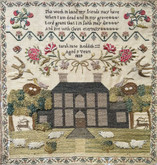What Are Samplers?
Samplers are pieces of embroidery or cross stitch traditionally used as a way to practice and showcase different stitches, alphabets, motifs, and decorative borders. More than just practice cloths, they became treasured keepsakes and cultural artifacts that tell stories of their makers’ skills, lives, and times.
Origins of Samplers
The earliest surviving samplers date back to the 16th century in Europe, though the practice of stitching small examples of embroidery for reference is believed to be much older. The word “sampler” itself comes from the Latin word exemplum, meaning “example.”
Before printed pattern books were widely available, needleworkers created fabric samplers as their personal reference libraries, preserving stitches and motifs they could use later in larger projects.
Why Did Women Make Samplers?
From the 16th through the 19th centuries, samplers became closely associated with female education. Young girls, often as early as six or seven years old, were taught to stitch samplers as a way to learn not only sewing techniques but also patience, discipline, and literacy.
Common reasons samplers were made included:
-
Skill-building: Practicing stitches and techniques.
-
Education: Incorporating alphabets and numbers to teach reading and counting.
-
Moral lessons: Featuring religious verses, proverbs, and sayings.
-
Family record: Documenting names, initials, and important dates.
-
Dowries: Showcasing needlework skills as part of marriage preparation.
Each sampler was highly personal, often reflecting the stitcher’s social background, religious beliefs, and regional traditions.
The Evolution of Samplers
By the 18th and 19th centuries, samplers had shifted from being practical stitch references to more decorative and symbolic works. They became framed pieces displayed proudly in homes, evidence of both skill and refinement.
During the Victorian era, samplers often featured ornate alphabets, Bible verses, and elaborate motifs such as flowers, houses, and animals. By the late 19th century, mass-produced embroidery patterns and needlework magazines reduced the need for hand-stitched reference samplers, leading to their decline as an everyday practice.
Samplers in Today’s World
Today, samplers are appreciated in two major ways:
-
Historical artifacts – Antique samplers are highly collectible and valued for their craftsmanship and the glimpses they give into women’s lives centuries ago. Museums and collectors carefully preserve them.
-
Modern needlework projects – Contemporary cross stitch and embroidery designers have reimagined samplers. They often incorporate playful motifs, quotes, and personalized designs, making them both nostalgic and fresh. Many stitchers today create samplers as heirlooms, personalized gifts, or decorative art for the home.
The tradition continues to evolve, blending historical inspiration with modern creativity.
Why Samplers Still Matter
Samplers remain more than just stitched fabric. They are a bridge between past and present, showing us how women expressed creativity, recorded personal histories, and passed down skills through generations. Whether antique or modern, samplers tell stories—and keep the art of needlework alive.
